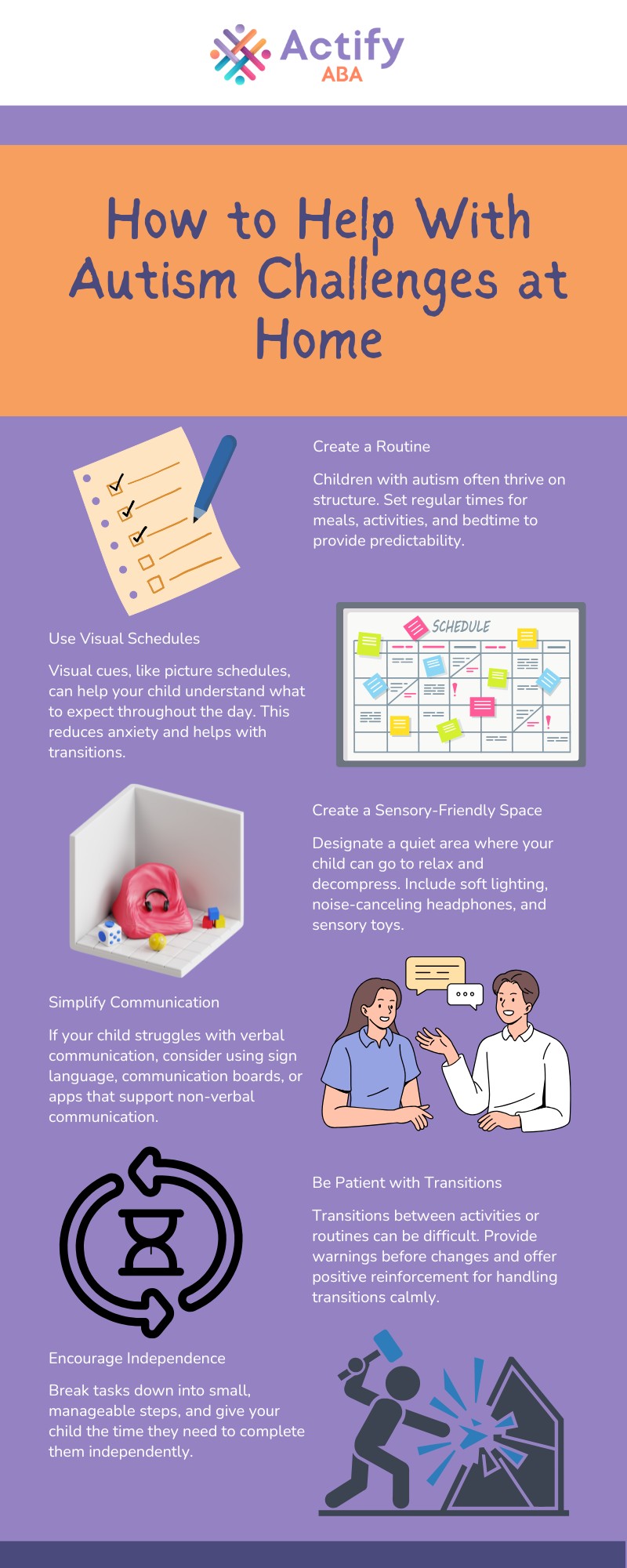
Key Points:
- The challenges of autism in everyday life are vast and varied, affecting children and adults in different ways.
- Communication difficulties and sensory sensitivities are key struggles in daily interactions and routines.
- ABA therapy offers a tailored approach to manage and overcome these challenges effectively.
Autism spectrum disorder (ASD) affects approximately 1 in 36 children in the United States, with a wide range of developmental, behavioral, and sensory challenges. The difficulties experienced by those on the autism spectrum are unique to each individual, but there are common struggles that families face in everyday life.
These challenges can impact basic routines, communication, social interactions, and sensory processing. Understanding the specific hurdles children or adults with autism may encounter is crucial in providing support and finding effective solutions. In this article, we will break down some of the major challenges of autism in everyday life and explore how therapies like ABA (Applied Behavior Analysis) can be helpful in addressing them.
What Are the Common Challenges of Autism in Everyday Life?
Individuals with autism face significant challenges in daily life due to communication barriers, sensory overload, and difficulty with social interactions. These challenges can make routine tasks, such as going to school, work, or simply participating in family events, extremely difficult. While each person with autism has a unique experience, the general struggles are often similar, and understanding these can help create better environments and strategies for support.

Communication Difficulties: Navigating Conversations and Social Interactions
One of the most prominent challenges of autism in everyday life revolves around communication. Many individuals with autism experience delays or difficulties in both verbal and non-verbal communication. This can manifest as a limited vocabulary, trouble understanding body language or facial expressions, or difficulty in forming coherent sentences.
For children, this means that simple tasks like asking for food, expressing emotions, or engaging with peers can be overwhelming. The inability to communicate effectively can lead to frustration and sometimes behavioral outbursts. As a result, these children may avoid social interactions, further complicating their ability to integrate into everyday settings like school or family gatherings.
Common communication challenges include:
- Limited use of speech or language makes it hard to express needs or desires.
- Difficulty understanding social cues, such as tone of voice or body language.
- Challenges in maintaining a back-and-forth conversation, leading to social isolation.
ABA therapy can be particularly beneficial for improving communication skills. With the help of an experienced therapist, children with autism can learn to use verbal and non-verbal communication tools to express themselves more effectively.
Sensory Sensitivities: Overload and Overwhelm
Many individuals with autism experience heightened sensory sensitivities. This could mean being overly sensitive to lights, sounds, textures, or even smells, making ordinary situations, like going to the grocery store or attending a social event, extremely overwhelming. For a child with autism, the bustling sounds of a playground, the feel of certain clothing, or the bright lights in a classroom may become unbearable.
These sensory sensitivities can lead to meltdowns or aggressive behaviors as the individual struggles to cope with overwhelming stimuli. It’s important for parents and caregivers to understand that these reactions are not intentional but are caused by a sensory overload that the child cannot process.
Common sensory issues include:
- Over-sensitivity to loud noises, like alarms or sirens.
- Discomfort with specific textures, such as certain fabrics or foods.
- Sensitivity to bright lights, causing discomfort in busy environments.
Working with a trained therapist who understands these sensitivities can help develop strategies for coping with sensory overload. ABA therapy can also be used to desensitize an individual to particular stimuli gradually and provide strategies to manage overwhelming situations.
Difficulty with Routines and Transitions: Navigating Change
For many individuals with autism, maintaining a consistent routine is crucial. Changes in daily schedules or unexpected transitions can cause confusion, anxiety, or even panic. Whether it’s a change in school schedule, a family vacation, or even just a shift in mealtime, transitions can be very challenging.
This need for predictability is deeply tied to the way the brain processes information and anticipates future events. When something disrupts this routine, individuals with autism may struggle to adjust, which can cause emotional distress or behavioral challenges. Parents often experience difficulties when their child is resistant to change, whether it’s a small shift like a different route to school or a major event like switching classrooms.
Ways that routine and transition difficulties show up:
- Anxiety or distress when routines change unexpectedly.
- Resistance to trying new activities or changes in the environment.
- Behavioral outbursts when a transition takes place.
Behavioral therapies such as ABA can help individuals with autism learn to manage transitions by preparing them in advance and providing consistent, structured routines.
Social Interaction Challenges: Building Friendships and Understanding Others
Many individuals with autism face challenges in social interactions. This can involve difficulties with interpreting social cues, such as understanding when to speak or how to maintain eye contact. The concept of “reading” a social situation—deciphering others’ emotions and intentions—may be particularly difficult for some individuals on the spectrum.
Children, in particular, may struggle to make friends or connect with peers. This isolation can contribute to feelings of loneliness, especially as they grow older and realize they are different from others. They may not instinctively understand group dynamics or how to engage in reciprocal social exchanges, which are crucial for building relationships.
Social interaction challenges include:
- Struggling to understand social norms, like turn-taking in conversation.
- Difficulty recognizing and responding to the emotions of others.
- Limited interest or participation in group activities or games.
ABA therapy is an effective way to teach social skills in a structured environment. Through consistent practice, individuals with autism can learn how to interpret social cues, engage in conversations, and build meaningful relationships.
The Impact on Daily Activities: Managing School, Work, and Family Life
For children with autism, everyday tasks like going to school, following class routines, or participating in after-school activities can be incredibly taxing. These children might have a hard time focusing, understanding instructions, or following through with tasks. School activities, especially those that require group participation, might be overwhelming and lead to behavioral issues.
As children transition into adulthood, the challenges of autism in everyday life extend into the workplace, where they might have difficulties with communication, staying organized, or adapting to changing environments. Balancing family life also becomes more complex, as parents and caregivers must constantly adapt their routines to accommodate the specific needs of their child with autism.
Examples of challenges in daily life include:
- Difficulty focusing during school or at work, leading to decreased performance.
- Behavioral issues during transitions between home, school, and extracurricular activities.
- Struggling with simple daily tasks like grocery shopping or managing personal hygiene.
ABA therapy can help individuals with autism develop strategies for staying organized, managing tasks, and reducing frustration in daily activities.

By integrating these strategies, you can create a home environment that supports your child’s development while minimizing stress for both of you.
How ABA Therapy Can Help Address the Challenges of Autism in Everyday Life
ABA therapy is a structured, research-based approach to helping individuals with autism improve their communication, social, and behavioral skills. By breaking down complex tasks into smaller, manageable steps, ABA helps individuals learn new skills in a gradual, reinforced manner. This approach is tailored to meet the unique needs of each individual and can be used to address many of the challenges of autism in everyday life.
ABA therapists work closely with parents and caregivers to provide ongoing support, implement behavioral strategies, and track progress. This consistency helps individuals with autism improve their ability to navigate the world around them, whether it’s in social settings, school, or family life.
Get ABA Therapy in Maryland – Helping Your Child Thrive
At Actify, we offer ABA therapy in Maryland to help children with autism overcome everyday challenges. Our team of expert therapists works closely with families to create personalized treatment plans that focus on improving communication, behavior, and social skills. If you’re facing the challenges of autism in everyday life, we’re here to support you. Contact us today to learn more about how ABA therapy can help your child thrive and navigate their world with confidence.
